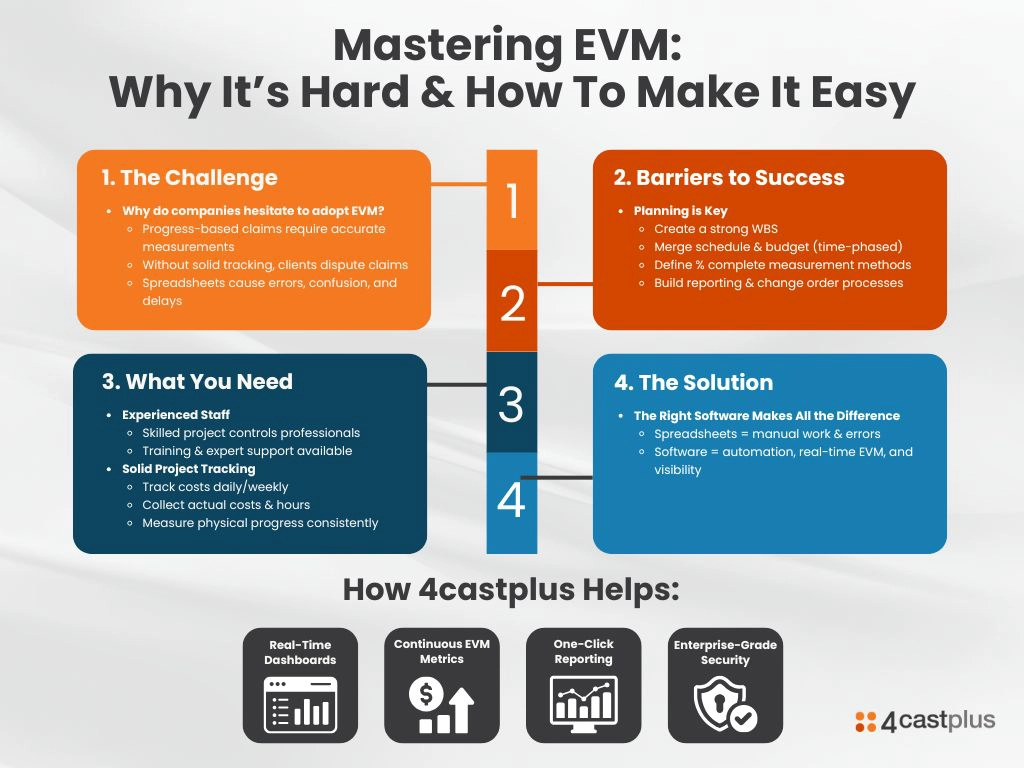Read In 4 Minutes
When To Use EVM
When faced with being responsible for a large construction project, skilled project managers will create a project plan, schedule and budget that reflects the scope, cost and timeline of the project. Planning even a modestly large project can take weeks to develop in order to capture all the details, deliverables, dependencies and detailed budgets. Even with very careful planning, however, construction projects can still go horribly wrong. They can easily wind up over budget and behind schedule – with an angry customer to report to. That’s because projects at this scale are chaotic, risky and have endless layers of complexity. And the larger the project, the greater the complexity and the greater the risk of failure.
Any experienced contractor or owner that takes on a large project will adopt measures to manage their financial and schedule risk exposure. Such as applying a contingency, inserting contractual language to cover for unforeseen changes or anomalies, and implementing fall back plans. Among other things.

The savviest of contractors and owners will also put project controls practices in place to minimize all that risk. By doing this project managers give themselves the tools to easily spot challenges on the project early on so that they can stamp them out while these challenges are still small. Most major projects will fail due to a lack of visibility. Without applying project controls practices, issues are easily missed; and even small issues can escalate into much bigger issues before they’re noticed. Taking corrective action on issues while they’re small is relatively trivial compared to after they’ve dug their hooks into things, and have to be disentangled before they can be fixed – which can be expensive in cost and time. This is especially important for high-value, multi-stakeholder projects that carry significant financial risk.
Applying project controls practices is a low-cost and practical approach to reigning in the potential of projects going off track. This is where Earned Value Management comes in.
Understanding EVM
EVM is a practice of project planning and tracking that provides key metrics for analyzing how well a project is performing – and the tools for taking corrective action for when things are not going to plan. It’s very common for glitches and setbacks to go unnoticed unless there is data and reporting to draw attention to them. Without the analysis provided by EVM, project managers are literally in the dark as to what is going on. They have to rely on their own observations, along with a considerable amount of intuition and luck, to keep the project on track. Those soft skills may work on smaller jobs, but major projects are far too complex to simply hope for the best. EVM not only provides hard facts to support those observations and intuition, it also sheds light on any issues that fly under the radar. Issues that can cause big surprises later on.
EVM answers 3 essential questions about the project, and every task on the project:
- Is the project/task over or under budget?
- Is the project/task ahead or behind schedule
- What is it forecast to cost and when is it forecast to finish
It not only provides reliable answers to those questions, it also provides the data to support them, along with insights as to how to course-correct any anomalies.
Learn More About Earned Value Management
Why Hesitate Using EVM?
Given the fact that EVM significantly derisks major projects at a very low cost, you would think EVM practices would be far more common. But the reasons why some haven’t yet adopted EVM on their large projects are most often the following:
- EVM requires more upfront project planning
- EVM requires in-house expertise
- EVM requires more careful project tracking
- You need a system that specializes in EVM
While all of those things are true, they are a trivial investment considering the fact that EVM pays off in multiples. Let’s briefly discuss these objections so that we can put them into context.

1. For EVM, Planning is Key
There’s no question that embedding project controls practices and EVM into a project requires a shift in thinking towards more of an emphasis on project planning. Which is something you could say about anything important in life. But this shift to better planning translates into a few things:
- Work Breakdown Structure (WBS) design. The WBS should be designed in a way that facilitates the tracking of actual costs against the original budget; as well as tasks that can be progressed.
- Time-phasing the budget. This means that the project budget needs to be merged with the schedule so that project cash flow can be viewed over time.
- Plan for Progress Measurements. Each task on the project gets underway, it needs to be measured in terms of percent complete. Some tasks can take months to complete, so during that time, they need to be regularly assessed for how far along they are. While planning each task therefore, the project manager needs to ask, “how are we going to progress this task?”
- Reporting and Analysis. Project managers need to plan how they’re going to report on the project both for their own purposes, along with how they report to other stakeholders. Their more detailed reporting needs to have the analytics for them to pinpoint the root causes of any issues that need to be addressed.
- Manage Change Orders.
2. Implementing & Practicing EVM Requires Experienced Staff
If you already have people experienced in project controls and EVM, you’re off to a great start. If you don’t, don’t let that deter you from jumping into it. As long as you have people that are willing to learn, that’s a blessing. Here at 4castplus, we have very experienced staff that can help you get the system configured and your team (experienced or not) setup for success. Our staff can also jump in to train your key personnel on EVM, project planning, reporting, analysis, and much more.
3. EVM Relies on Solid Project Tracking
Most organizations track their projects at least to some extent. Whether it’s tracking labor & equipment for the purposes of reporting, billing and payroll – or you’re tracking subcontractors & suppliers for payables. There’s a good chance that there are processes in place to track hours & costs on a daily basis. The things that might be missing are:
- Tracking everything that incurs a cost. Tracking cost for EVM means you really want to achieve full cost coverage so that you can compare your actuals against your budget. This may mean you need to include some additional tracking.
- Tracking Progress. Progress tracking can require some extra thinking and planning. It can mean tracking physical units completed. For instance, items installed, deliverables completed, etc. Tracking is important for determining percent complete.
- Track in real-time. Tracking costs daily is ideal, but if that’s not achievable, then weekly is fine. The objective is to give early notification of issues as they appear.
Collecting project costs & hours is key for EVM. “Actual Cost” is a key input for EVM metrics to be calculated.
4. EVM Delivers Its Full Value With The Right Software Platform
There’s no question that EVM software takes on much of the heavy lifting and grunt work involved with both the setup and execution of a project. With 4castplus, for example, the majority of the EVM configuration is done well ahead of time during the initial implementation. This sets the stage for a tremendous amount of automation while the project is underway. Project managers can take advantage of real-time dashboards, analytics, and single-click reports. In addition to the fact that the system is continuously calculating EVM metrics for you. Metrics that are well-tested, trusted and in nicely formatted reports out-of-the-box.
While it’s possible to manage a major project using EVM on a large, multi-tab spreadsheet; the effort to set that up and operate it is very manual, labor intensive, prone to errors, and very fragile. You would have to hire people just to manage the spreadsheet. At which point, you’ve spent more than a software platform would cost you.
An Effort That Really Pays Off
Adopting EVM practices isn’t hard, but it is a shift in thinking. And a shift in where you apply your effort when managing major projects. i.e. more upfront planning. When you plan ahead, you have less effort while executing the project. When you don’t plan ahead, you burn pointless calories weathering the deep chaos of putting out avoidable fires and doing backflips in Excel.
Adopting EVM gives your teams many gems of increased competence and reliability, including:
- Deep Project Visibility – Detailed insights into project productivity and performance
- Early Risk Detection – Identifies problems before they escalate
- Ability to Forecast Project Outcomes – Predict cash flow, final budget and timeline
- Realistic Progress Measurements – Measure percent complete objectively and with defensible accuracy
- Improved Decision-Making – Allows project controls professionals to make quick, informed decisions based on trusted data
- Stakeholder Confidence – Reliable reporting and timely, evidence-based data gives internal and external stakeholders and customers the trust and confidence in your teams
- Reducing Financial and Schedule Risk – Eliminate project overruns and failures with early-detection of problems
Learn More
Want to learn more about how 4castplus can help you take control of project costs? Whether you’re facing budget overruns, delayed change orders, or disconnected systems, 4castplus delivers real-time visibility, accurate forecasting, and streamlined cost management—all in one platform. Discover how you can simplify processes, eliminate manual errors, and ensure every project stays on track, on budget, and ready to scale.
 Platform
Platform Solutions
Solutions Owners
Owners Contractors
Contractors Engineering/EPCM
Engineering/EPCM Professional Services
Professional Services Resources
Resources White Papers
White Papers Case Studies
Case Studies Blog
Blog Videos
Videos Frequently Asked Questions
Frequently Asked Questions Company
Company About
About

